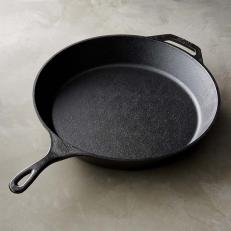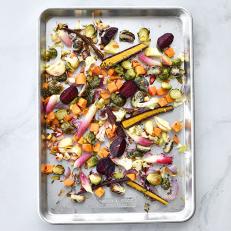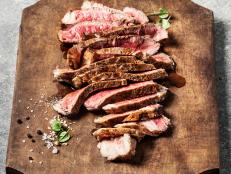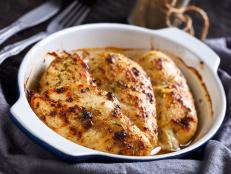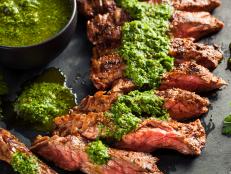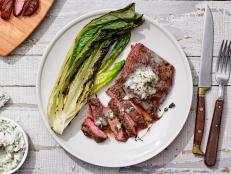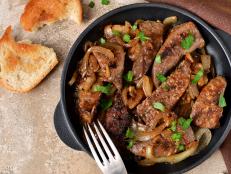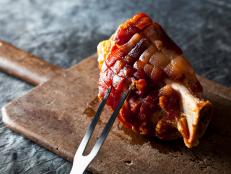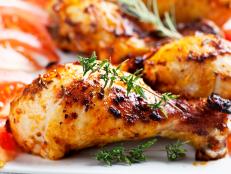How to Cook Steak In the Oven
Learn to cook steakhouse-quality steaks in your home oven.
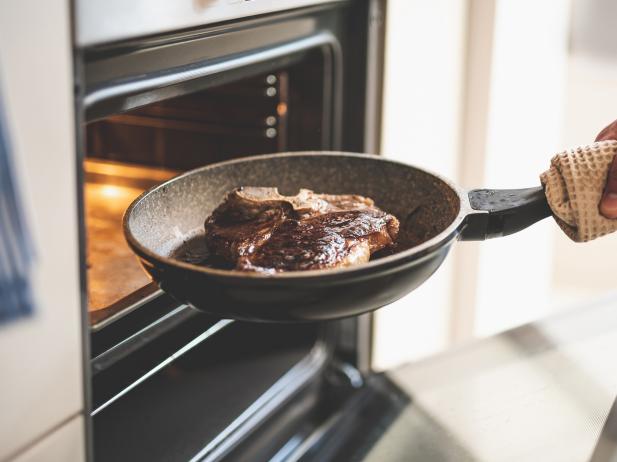
YakobchukOlena/Getty Images
By Carlos C. Olaechea for Food Network Kitchen
Going out to a steak house is a feast for the senses, and the experience is designed to make diners feel like royalty. However, you can easily recreate a steakhouse experience right at home and tailor it just to your liking. Want frito pie with your filet mignon? Go for it! The best part is that almost every home cook is armed with a super effective secret weapon to cook a perfect steak: your oven! Let us show you how you can cook a juicy, luscious steak in your home oven, from choosing the right cut to deciding on the right technique.
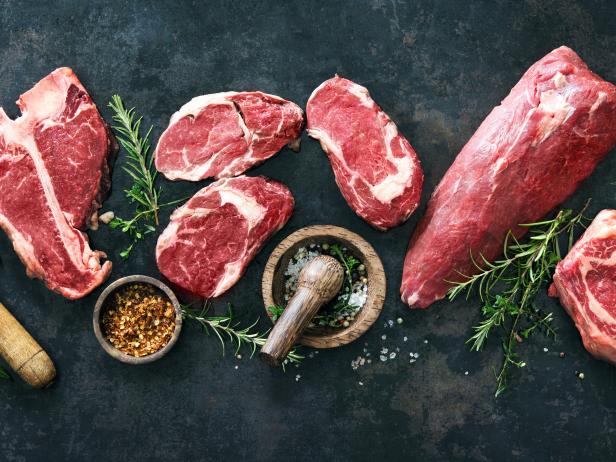
AlexRaths/Getty Images
How to Choose the Right Cut of Steak
Not all cuts of beef are created equal, and not every cut is the right cut for a steak. Even among steaks, each type has a different flavor, fat content, texture and price point. Before getting into the how of cooking a steak in the oven, it’s important to know which cut is best for you.
- Tenderloin: This cut is also referred to as filet. This cut is meltingly tender and lean. However, it is often the most expensive cut of steak, and because it doesn’t have as much fat as other cuts, it has a more subtle taste.
- Sirloin: This is a semi-lean cut with just enough fat marbling to keep the steaks moist during cooking. This part of the steer is divided into the top sirloin and the bottom sirloin. The top sirloin is smaller, more tender, and pricier. The bottom sirloin (often just called sirloin) can cost about 10 to 30 percent less, but it’s not as tender as the top sirloin.
- Ribeye: This cut is from the rib section, and the bone is usually removed. Bone-in ribeye steaks are sometimes called cowboy steaks. This cut is very well-marbled, giving it an intense beefy flavor. It’s not as tender as tenderloin but still up there among the most melt-in-your-mouth cuts.
- NY Strip: This cut is not terribly tender and doesn’t have as much marbling as a ribeye. As such, it’s often one of the least expensive cuts of steak. It’s still one of the most tender cuts of beef, overall, which is why it’s a great bargain for steak-lovers. It also has an assertive beefy flavor.
- T-Bone: This cut got its name from the t-shaped bone that runs down the middle of each steak. On one side of the bone there’s a NY strip, while the other side offers a bit of tenderloin. While cooking, the fat from the NY strip side melts into the filet side, making for a very flavorful and tender piece of meat. Porterhouses are a type of T-bone that has a larger piece of tenderloin – at least 1.25 inches wide.
- Hanger: Hanger steak is a bit of a hidden (and affordable) gem because it looks a bit gnarly when it’s first removed from the cow. However, butchers and savvy carnivores know better. With a little trimming it’s one of the most tender and intensely flavorful cuts of steak and often less expensive than a ribeye.
- Flat-Iron: Generally affordable, this cut is a good choice for first-time cooks. Flat-iron steaks have a lot of connective tissue and silver skin – that tough, shiny film that covers certain cuts of meat, so make sure you ask your butcher to trim it. You'll walk home with beautifully marbled steak with rich, beefy flavor.
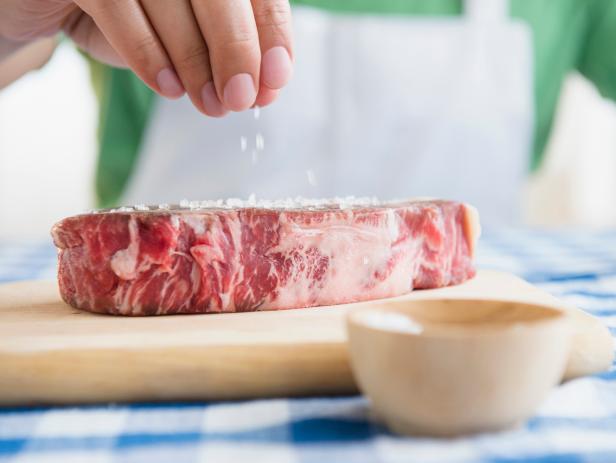
JGI/Jamie Grill/Getty Images
How to Prep Steak for the Oven
You chose your cut of steak and are ready to fire up your oven. Enthusiasm is a great attitude to have in the kitchen, but there are still a couple of steps you need to take.
1. Let It Come to Room Temperature
A cold steak in a blazing oven will cause steam to form, which will prevent your steak from browning. You’ll end up with a watery-tasting grayish steak. Pull your steaks from the refrigerator about thirty minutes before you fire up the oven.
2. Dry Off the Steak
The best steaks have a beautifully browned exterior that’s just slightly crisp. To get that most desirable quality on your at-home steaks, you need to make sure that the outside of your meat is dry. If you’re short on time, you can definitely pat your steaks dry with paper towels before seasoning, and they’ll be ready to cook. However, if you have a little more time, it’s best to season your steaks and then let them chill out uncovered in your refrigerator for a couple of hours and ideally overnight. The salt will have time to permeate the meat while also drawing out some of the moisture. At the same time, the cold air will dry the exterior of the meat better than any paper towel can.
3. Season It with Salt and Pepper
Steak is one of those foods you want to shine on its own. You don’t want to go overboard with the spices and then not even taste the beef, especially if you opted for a more expensive cut. Nevertheless, you do need to season your steak to bring out its full flavor. A generous sprinkling of salt is all you really need. A little bit of pepper can add some bite, and some opt for whisper of sugar to help with caramelization. Save your herbs and other seasonings for the sauce, or better yet, make a compound butter.
4. Gather Your Equipment
The good thing about cooking steaks in your home oven is that only need a few tools.
- Sheet pan: Depending on which approach you take, you might need a sturdy sheet pan and some foil.
- Skillet: A cast iron skillet is a classic choice for cooking steaks at home, although a heavy stainless steel pan also works. Check with your pan’s manufacturer before using nonstick. If you plan to sear your steak, you may want to avoid Teflon-coated nonstick pans as they oftentimes cannot handle higher temperatures without becoming damaged.
- Instant read thermometer: A thermometer is helpful to have, but not necessary. Take the steak's temperature after you have cooked your steak for the recommend time and only if you have doubts about whether or not it’s done to your liking.
Everything You Need
How to Cook Steak In the Oven
There are actually as many ways to cook your steak in the oven as there are people who cook their steaks in the oven. Take a look to see which one will work best for you.
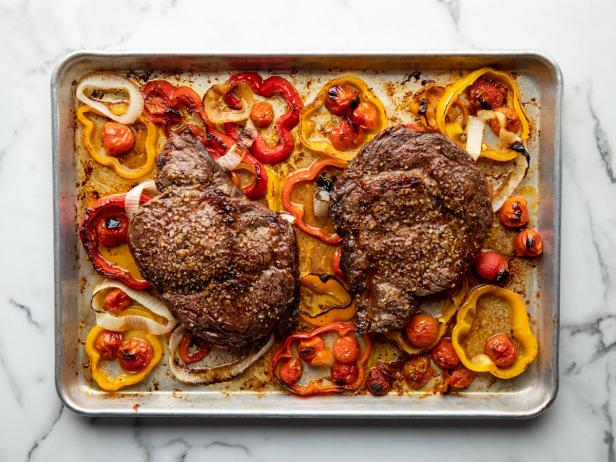
The Sheet Pan Method
Best for: This method is best if you feel a little intimidated searing a steak or handling a hot skillet. This technique may not give you exactly a steakhouse-quality steak, but it is also the least fussy approach on this list and perfect for a novice cook.
What to do: All you have to do is preheat the oven, place your seasoned steaks on a cold sheet pan and broil for five minutes on one side and three minutes on the other side for 1.5-inch steaks. Curious? Check out Ree Drummond's Sheet Pan Supper, which includes onions and bell peppers.
The Oven Skillet Method
Best for: This method is almost as hands-off as the sheet pan method. However because you place the steak into a preheated skillet, you'll achieve a better crust than the sheet pan method.
What to do: A cast-iron skillet is particularly useful for this approach to cooking steak. Simply place it in the center rack of a cold oven and preheat your oven. When your oven comes to temperature, use an oven mitt to carefully remove the skillet, add your steaks, put the skillet back in the oven and cook until it's deeply seared on one side. Then, flip the steaks using a pair of tongs and cook for a few more minutes, depending on how you like it cooked.
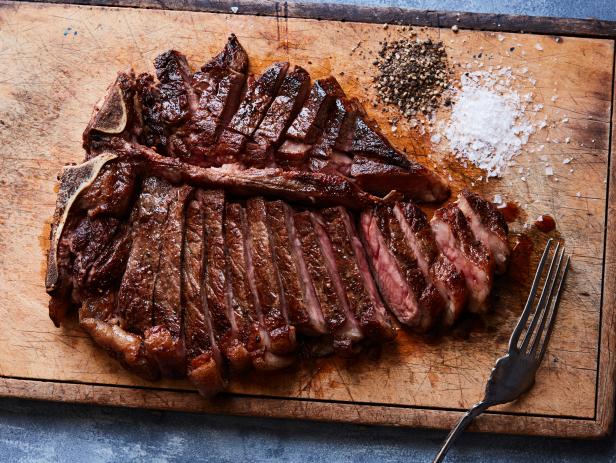
Matt Armendariz
The Sear and Oven Method
Best for: This is a great all-purpose way to cooks steak and develop a gorgeous crust. Many restaurants use this technique.
What to do: The process is almost exactly what it sounds like: you first sear your steaks on a pan or skillet over high heat just to brown the exteriors. Afterwards, you place your steaks in the oven set to a moderately low heat to finish the cooking. This can take about five to seven minutes for medium rare and a bit longer if you like your meat more cooked in the middle. For a full how-to, check out Food Network Kitchen's Pan Seared T-Bone Steak.

The Reverse Searing Method
Best for: This method calls for cooking the steak at a low temperature first in the oven and then searing it to get a gorgeous brown crust. The method has two very big advantages for the steak connoisseur. When you cook steaks in a very hot oven, you have a tiny window in which you can remove your steaks at just the right level of doneness. If you wait a few seconds too long, you may end up with an overcooked steak. If you’ve got mashed potatoes to whip up or a salad to toss, you may not be able to drop everything to take out your steaks. Cooking them in a low oven, however, gives you more time to add that extra pat of butter to your taters or crack of pepper to your salad. As well, finishing your steaks with a sear (as opposed to starting with it) ensures a crispy, chestnut-brown crust that gives way to a super moist piece of meat.
What to do: Season your steak and let it come to room temperature. Then bake it in a low-temperature oven until the desired internal temperature is reached. Then sear the steak in a skillet on the first side for about a minute. Flip the steaks and add a big knob of butter to the skillet. Once the butter has melted, continue to cook the steaks, continuously basting with the melted butter, until seared on the second side, about 45 seconds. For more info, check out our story How to Reverse Sear a Steak. Or see for yourself and try cooking Jeff Mauro's Reverse Seared Ribeye.
How Long Should the Steak Rest?
You selected the perfect cut of cow, did all the necessary prep work and cooked it like a pro. Now it’s time to dig in, right? Not yet. You don’t want to pierce your steak until it’s had some time to rest. There are various explanations for why this step is important. Some are more imaginative than others. What many home cooks and restaurant chefs agree on, though, is that if you cut into a steak too early, all the juices will run out immediately, leaving the meat dry in the end. Letting your steaks rest for 10 to 15 minutes lets the juices settle into the meat so that each bite you take is equally succulent.
Related Links:
























